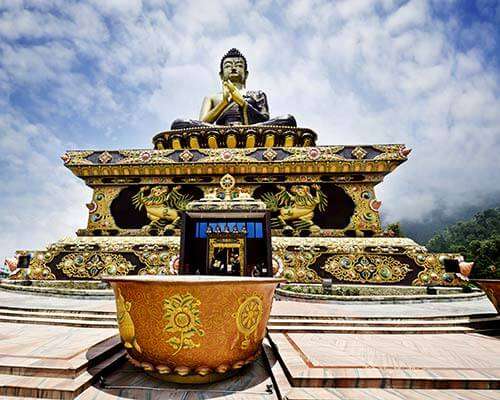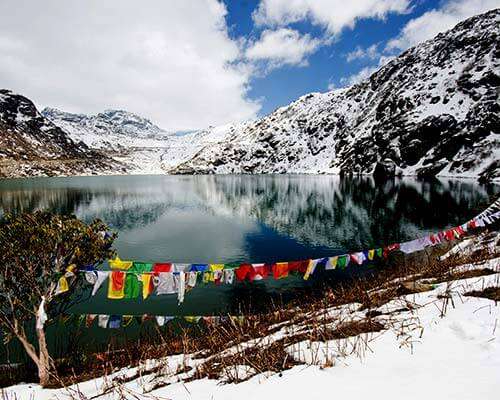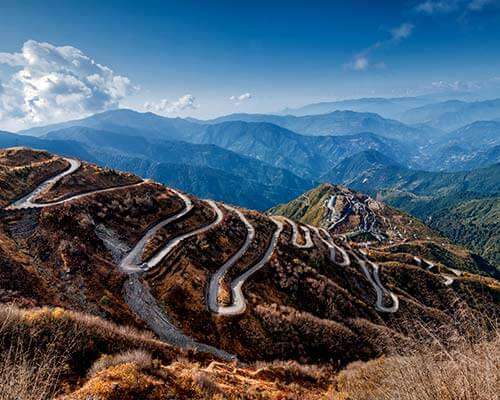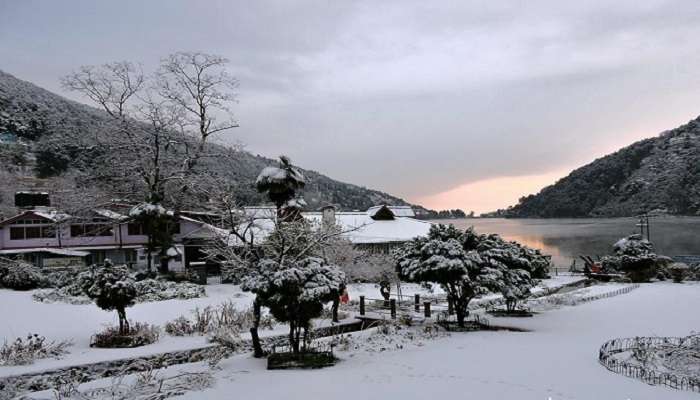The Ever Growing Living Root Bridges, Meghalaya – A Nature’s Marvel In The Northeast

There are bridges around the world that are known to be human’s finest creations! But the natural marvel of Living Root Bridges in Meghalaya is mindblowing. These wonderful structures have meticulously grown over a period of time and are among the biggest attractions in Meghalaya. The ever evolving Meghalaya bridges are made up of tangled thick roots that provide formidability to the structure and make it good enough to hold 50 or more people in one go. They are grown by trained Khasi and Jaintia tribes who have mastered the art of growing root bridges across raised banks of streams running through the dense woods of Meghalaya.
Living Root Bridges: History & Facts

The whole idea of Meghalaya’s living bridges came into the picture some two centuries ago (180 years precisely) when veterans of Khasi clan living in Meghalaya put rubber tree roots into hollow canes of Areca nut palm that met halfway across the stream. The roots were nurtured and cared properly until they grew enough to reach the opposite bank, get completely entwined with each other, and make themselves capable enough to carry heavy weight.

Some of the interesting facts about these bridges are:
- The Living Root Bridges are made from rubber tree roots also known as Ficus elastica tree.
- Some of the root bridges are over 100 feet long and take 10 to 15 years to attain the perfect shape.
- Once fully grown, these roots last for as long as 500 years. While some of the roots decay because of their continuous association of water, others grow and make up for the decayed, thus providing the required stability to the bridge.
- Of all the Living Root Bridges in Meghalaya, the double-decker root bridge in Cherrapunji and the single-decker root bridge in Shillong are the unique bridges in the world and make for prime attraction in the Northeast.
- Living Root Bridges in Meghalaya are recognized by UNESCO as a World Heritage Sites.
Suggested Read: 11 Reasons To Visit Cherrapunji That Make It A Heaven On Earth
Sikkim-Gangtok-Darjeeling Holiday Packages On TravelTriangle
Visit Sikkim and explore Yumthang valley, Tsomgo Lake, Gangtok, Nathula Pass, and Pelling. Experience peace and tranquility while exploring Buddhist monasteries, snow-capped mountains, and wildlife sanctuaries. Book packages inclusive of airport transfers, cab, resort, sightseeing, and meals.
Living Root Bridges: Location
Living Root Bridges are found in West Jaintia Hills district, East Khasi Hills district, and a few other areas of Meghalaya that are among the places in India that deserve more travelers. However, the best root bridges are concentrated in Cherrapunji and Shillong. Here is how to reach these beautiful destinations. Both these towns are accessible from Guwahati.
How to reach Shillong & Cherrapunji from Guwahati

Guwahati being a major city in the Northeast India acts as a hub for everyone traveling to the region. One can easily find plenty of commuting options to all the places in the Northeast from Guwahati.
By air: Guwahati airport at a distance of 123 km from Shillong, is well connected with major airports in India. Reserved cabs are mostly preferred by people to come down to Shillong from the airport. Shillong to Cherrapunji is 54 km, which is a 2-hour ride by a local bus or a cab.
By train: Guwahati Railway Station is the nearest railhead to Meghalaya. It is very well connected to other major railway stations across India and commuting to Shillong and other major cities of the Northeast India is quite convenient. The 148 km distance between Guwahati to Cherrapunji can be covered in 4 hours by a taxi or a private/government bus.
By road: Volvo buses and government buses run from Guwahati to Shillong and Cherrapunji run in tandem at regular intervals. The 99 km distance between Guwahati to Shillong is full of exciting views, which is indeed a treat for all the travelers.
Best time to visit the Living Root Bridges in Meghalaya
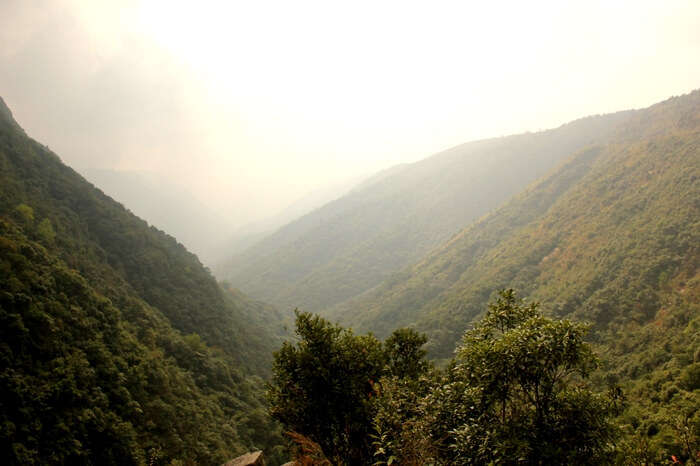
Meghalaya boasts of an equable climate throughout the year. The weather is pleasant and misty for the most part of a year. However, avoid the monsoon season – from June to August – because roads become slippery. Walking in the woods and descending steps also becomes difficult.
For the rest of the year, just pack your bag and don’t forget to carry enough winter clothes.
Suggested Read: 30 Best Places To Visit In India In January
Double-decker Living Root Bridge in Cherrapunji
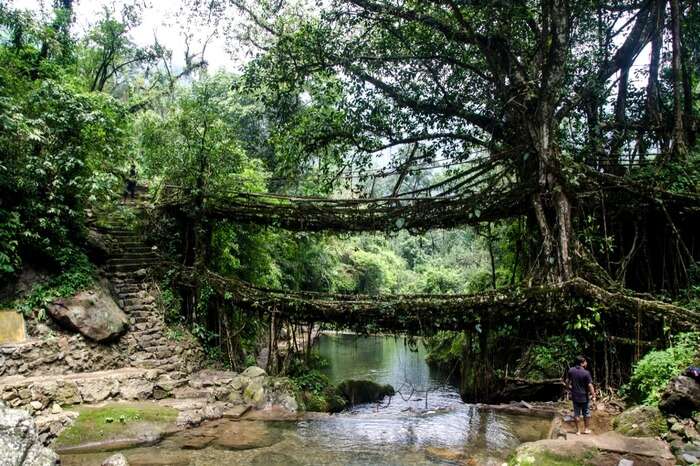
The 30 meters long bridge stands 2400 feet high and is the longest known Living Root Bridge, which also means that to reach the bridge one has to make a steep descent of 2400 feet. Having said that, the path from Cherrapunji to Umshiang root bridge is one of the most challenging treks and requires a lot of grit and stamina. It is said to be 180 years old and there are plans to add another level to the bridge.
Holding the proud distinction of being addressed as one of the most picturesque and beautiful places on earth, Cherrapunji at a distance of 56 km from Shillong, is a must-visit place in Meghalaya. Numerous waterfalls, misty environs, favorable climate throughout the year, and lush greenery make for some of the most prominent attractions for tourists from all over the world who flock to this peaceful retreat in the Northeast India.
How to reach Double-decker Living Root Bridge from Cherrapunji
The bridge is a 3 km trek from village Tyrna, which acts as the base village. Tyrna village is at a distance of 20 km from Cherrapunji. You won’t find too many buses running on this route, therefore, the fastest means of reaching the Double-decker Living Root Bridge is hitchhiking or sharing rides. However, Sumo taxis are one of the widely used vehicles for commuting in the region. The trek from Tyrna village is rather daunting and you must be in your prime fitness to scale the distance with ease.
Other popular Living Root Bridges in Cherrapunji are Ummunoi Root Bridge, Ritymmen Root Bridge, Umkar Root Bridge, Mawsaw Root Bridge. These bridges make exciting treks and must be visited once you are in Cherrapunji.
Single-decker Living Root Bridge in Shillong
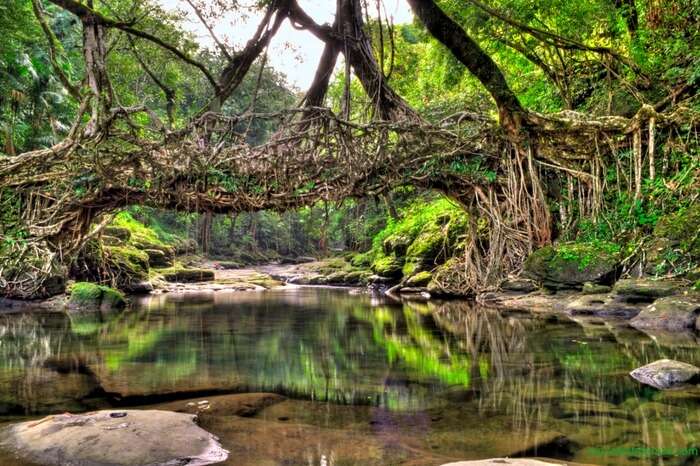
Single decker root bridge can be reached by a trekking a path that starts from village Riwai. This small village is very close to Mawlynnong – a quaint heaven that shot to fame in 2003 when it was adjudged as Asia’s Cleanest Village by the Discover India magazine.
Mawlynnong is a rough 3-hour ride from Shillong and is located close to the Bangladesh border. Come here to enjoy the splendid view of natural balancing rock, one of the major attractions in Mawlynnong. In fact, there are some really interesting places to see and things to do here, along with some warm homestays. Plan a vacation and see for yourself.
Must Read: Here’s Why The Cleanest Village In Asia, Mawlynnong Deserves More Tourists
How to reach Single-decker Living Root Bridge from Shillong
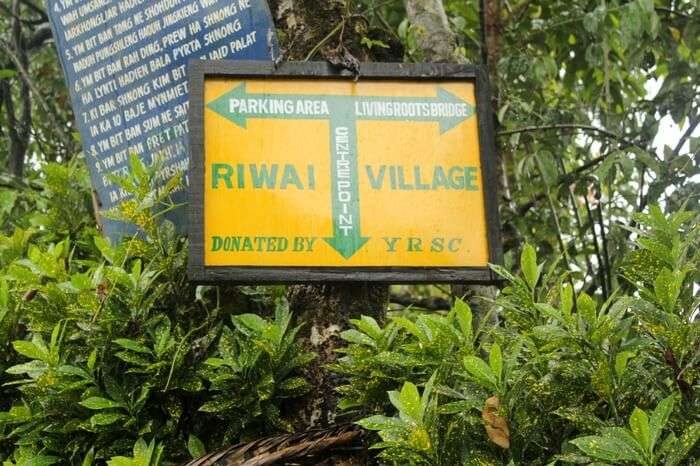
The distance between Shillong to Mawlynnong is 78 km, which can be covered by a 2.5-hour taxi ride. Take a shared Sumo or a jeep from Sumo Stand in Bara Bazaar, a 15-minute walk from Police Bazaar. For accurate directions, take help of localites.
To reach the Living Root Bridge one has to get down at Riwai village, few kilometers before Mawlynnong. The bridge is a 15-minute walk from there.
Further Read: 31 Reasons Why You Should Never Visit Northeast India
Meghalaya looks straight out of the sets of Hobbit. The charming locales of Meghalaya, be it woods, rivers, waterfalls, and wonders-out-of-the-world like Living Root Bridge, they all look so surreal. Visit this northeastern beauty to enjoy the best of nature and the marvel of Living Root Bridges.
Check out Dhilip’s Itinerary for Meghalaya Trip and book a trip to this beautiful land.
Disclaimer: TravelTriangle claims no credit for images featured on our blog site unless otherwise noted. All visual content is copyrighted to its respectful owners. We try to link back to original sources whenever possible. If you own the rights to any of the images, and do not wish them to appear on TravelTriangle, please contact us and they will be promptly removed. We believe in providing proper attribution to the original author, artist or photographer.
Please Note: Any information published by TravelTriangle in any form of content is not intended to be a substitute for any kind of medical advice, and one must not take any action before consulting a professional medical expert of their own choice.
Frequently Asked Questions About Living Root Bridges Meghalaya
How many living root bridges are there in Meghalaya?
There are 11 living root bridges in Meghalaya. They’re a 2.5 drive away from Shillong. The bridges have existed in Meghalaya since 1844.
How do I get from Shillong to Mawlynnong?
Shillong is 78 kilometres away from Mawlynnong. It only takes 2.5-3 hours to reach Mawlynnong from Shillong. From Shillong airport, you will easily get a taxi to Khasi Hills Sumo stand at Bara Bazaar market. From the market, you can take a shared sumo to reach Mawlynnong. On the way, you will come across some remarkable waterfalls in Meghalaya that will truly blow you away.
How are living root bridges made?
Living root bridges are made by putting young Ficus elastica roots though hollowed-out trunks of Areca nut palm trees. They’re built across rivers and streams. They grow through the trunks fast enough to attach themselves to the other side.
How far is root bridge from Shillong?
The distance between Shillong and a single-decker living root bridge is 78 kilometres, which can be covered within 2.5 hours via a private cab.
Is Meghalaya safe for tourists?
Yes, Meghalaya is safe for all tourists, especially backpackers and solo female travelers. If you’re a woman, please take precautionary measures that you would take in any other country that you’re traveling to. Carry a pepper spray with you at all times.
Which is the cleanest place in Asia?
Mawlynnong won the status of the cleanest place in Asia in 2003. It is a small village around 100 km from Shillong. It is truly a natural haven.
Why is Meghalaya known as living root bridge?
Meghalaya is known as a living root bridge because a number of root bridges are known to exist in the jungles. These bridges are made by Khasi and Jaintia tribes who have mastered the art of wrapping thick roots together to form a structure that has a capacity to hold more than 50 people.
Looking To Book A Holiday Package?
Book memorable holidays on TravelTriangle with 650+ verified travel agents for 65+ domestic and international destinations.
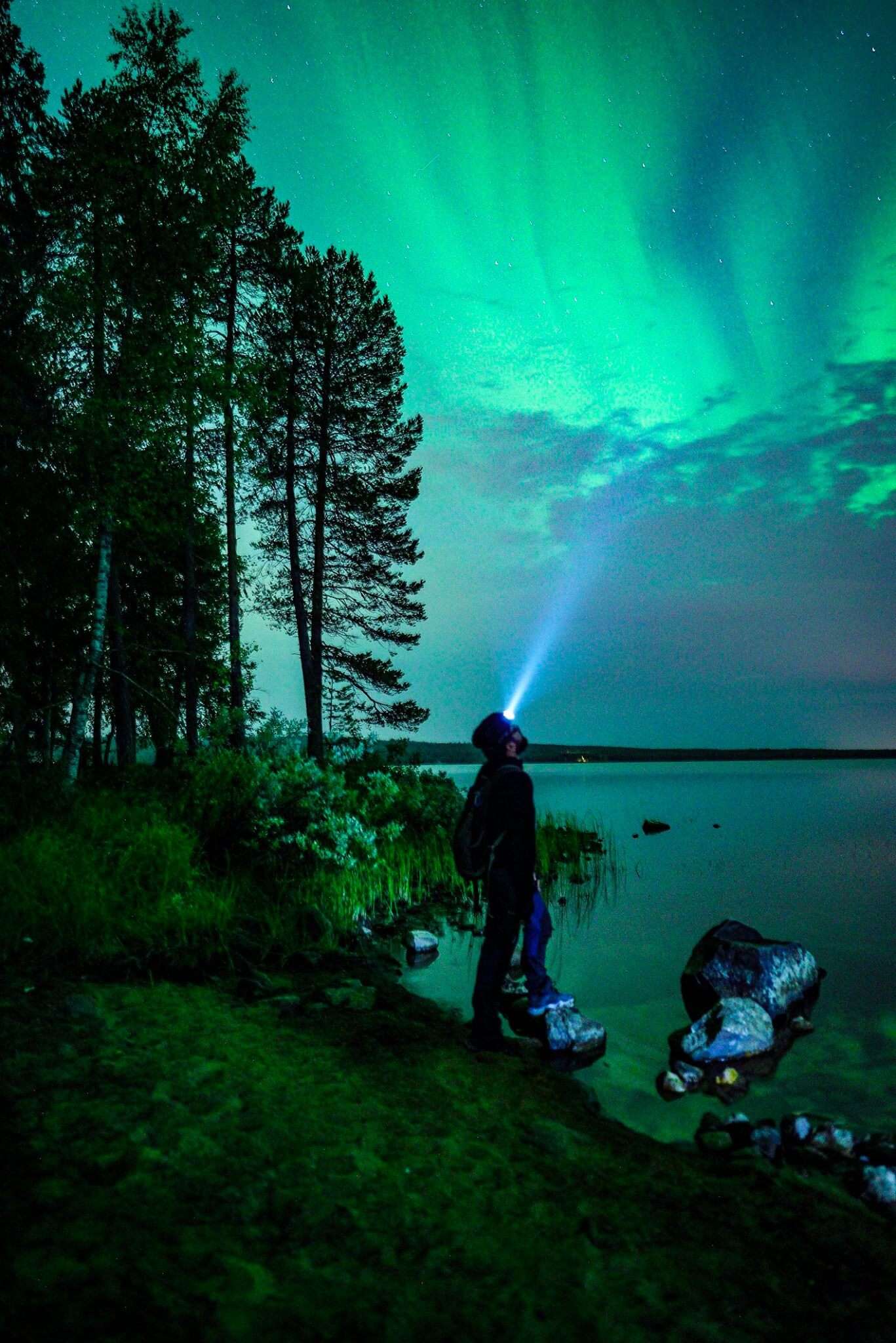
A perpetual nature seeker, Amit is on a mission to explore the best of planet Earth. Much famed as the Whistling Hound, Amit’s is currently based out of Wroclaw in Poland, and is experiencing the best of his life in Eastern Europe and Scandinavia.




